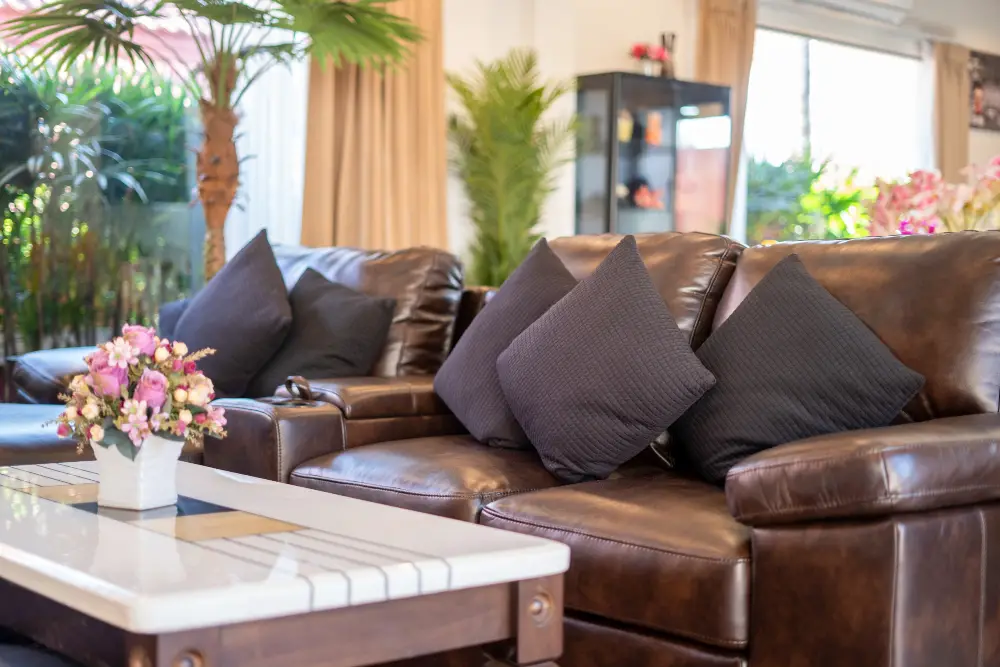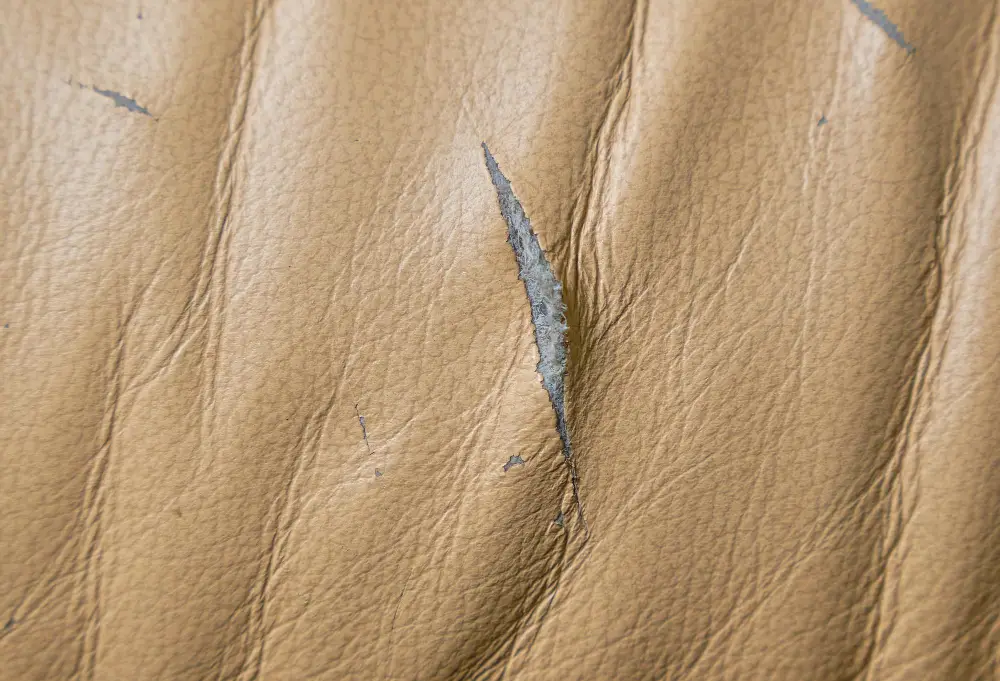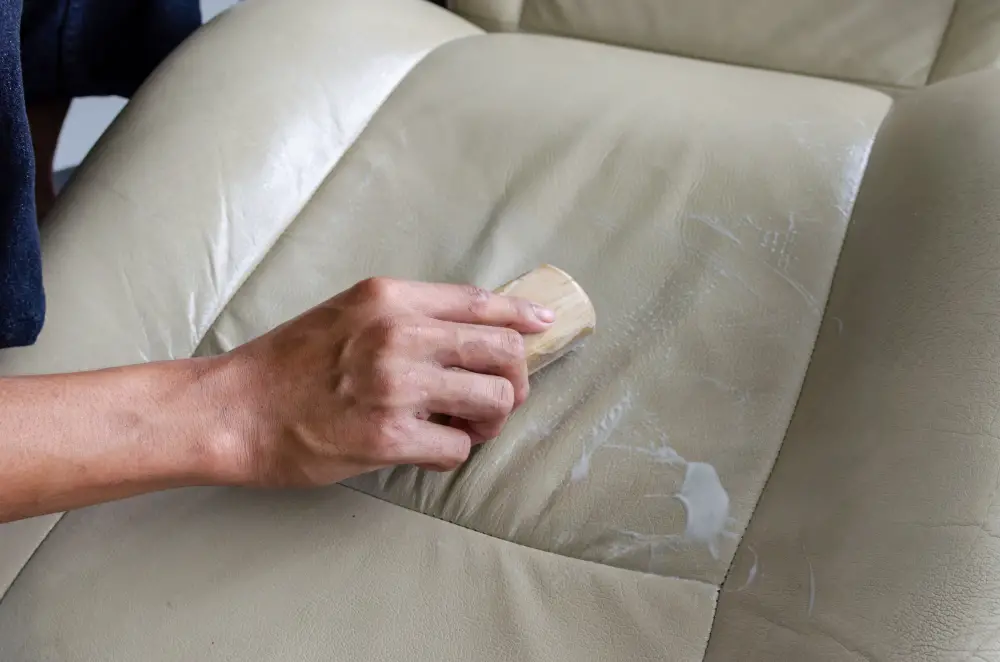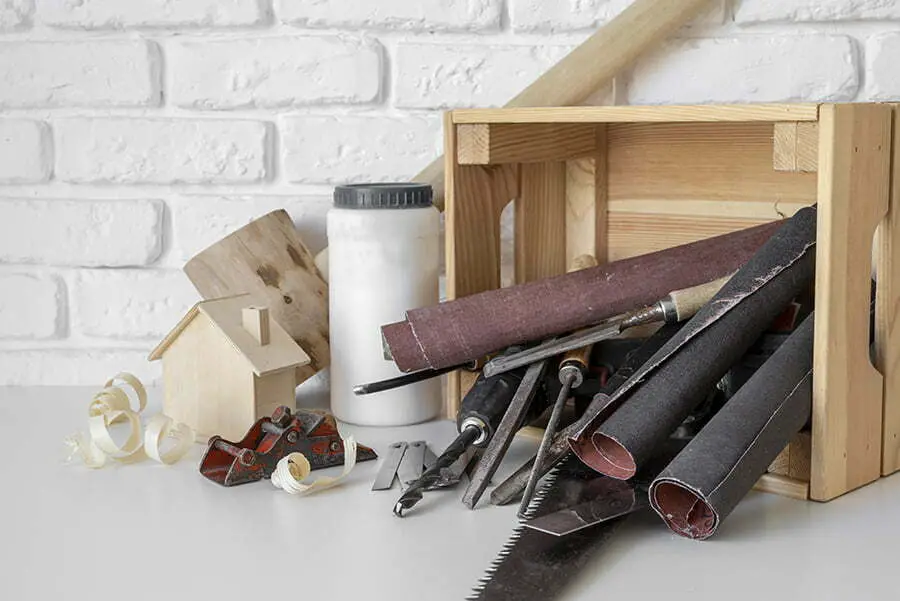Last updated on
Discover the simple steps to restore your peeling leather couch and bring it back to life in this comprehensive guide.
Leather couches are a popular choice among homeowners because of their durability and timeless appeal. However, even the most well-maintained leather couch can start to show signs of wear and tear over time.
One common issue that many people face is peeling leather on their couches. Not only does this detract from the overall aesthetic of the piece, but it can also be uncomfortable to sit on and potentially lead to further damage if left unchecked.
The good news is that fixing a peeling leather couch is not as daunting as it may seem. In this article, we’ll explore some simple steps you can take to restore your beloved leather sofa back to its former glory without breaking the bank or resorting to drastic measures like replacing it altogether.
Table of Contents
Understanding Leather Couch Peeling

Leather couch peeling is a common problem that many homeowners face. Understanding the root cause of this issue is crucial to finding an effective solution.
Peeling leather can be caused by several factors, including age, wear and tear, exposure to sunlight or heat sources, and improper cleaning or maintenance.
It’s important to note that not all types of leather are created equal when it comes to durability and resistance against peeling. Bonded leather and faux leather are often cheaper alternatives but tend to peel more easily than genuine top-grain or full-grain leathers.
To prevent your couch from peeling prematurely in the future, it’s essential first to understand what type of material you’re dealing with before purchasing any repair kits or products. By doing so, you’ll be able to make informed decisions about how best to care for your furniture piece moving forward.
Identifying the Type of Leather

Different types of leather require different repair methods and materials, so this step is crucial for ensuring a successful restoration.
One way to determine the type of leather is by checking the label or manufacturer’s information that came with your couch. If this isn’t available, there are other ways to identify it:
- Aniline Leather: This type of leather has a natural look and feel because it doesn’t have any surface coating or pigmentation. It will absorb water quickly and darken when wet.
- Semi-Aniline Leather: Similar in appearance to aniline but has a light protective coating on top that makes it more durable.
- Pigmented/Protected Leather: This is the most common type used in furniture manufacturing due to its durability and resistance against stains. It has a polymer coating on top which gives off an even color throughout.
- Bonded/Faux Leather: Made from synthetic materials like polyurethane (PU) or vinyl; these are not real leathers.
Causes of Leather Couch Peeling

There are several factors that can contribute to leather peeling, including age, exposure to sunlight and heat, lack of maintenance or improper cleaning techniques. Over time, natural oils within the leather can dry out and cause it to crack or peel.
Sunlight and heat can also accelerate this process by drying out the material even further.
Another common cause of peeling is using harsh chemicals when cleaning your couch. Certain cleaners contain ingredients that may strip away essential oils from your leather furniture causing it to become brittle over time leading eventually lead into cracking or flaking.
Bonded Vs. Faux Leather

Two common options that people often confuse with one another are bonded and faux leather. While both materials may look similar at first glance, they have distinct differences in terms of quality and durability.
Bonded leather is made from scraps of genuine leather that have been glued together to create a single piece. This material is typically less expensive than real or full-grain leather but still has some natural characteristics such as texture and smell.
Faux or synthetic leathers, on the other hand, are entirely man-made using plastic-based materials like polyurethane (PU) or vinyl (PVC). These fabrics can mimic the appearance of real animal hide without any actual animal products being used in their production process.
While both bonded and faux leathers may be more affordable than genuine hides initially, they tend to wear out faster over time due to their lower quality construction. Bonded leathers can start peeling after only a few years while faux ones might crack under pressure sooner rather than later.
Consumer Misinformation On Leather Types

Many people assume that all types of leather are created equal, but this couldn’t be further from the truth. In fact, there are several different types of leather used in furniture manufacturing, each with its own unique characteristics and maintenance requirements.
Bonded and faux leathers are two common materials often mistaken for genuine or top-grain leathers. Bonded leather is made by blending scraps and fibers together to create a material resembling real animal hide while faux or synthetic leathers use plastic-based materials to mimic natural hides’ look.
It’s essential to understand what type of material your couch is made from before attempting any repairs as using incorrect products can cause more damage than good. Take some time to research your specific sofa model online or consult a professional if you’re unsure about how best to proceed.
Signs of Quality Leather Material

High-quality leather will not only look better but also last longer and be easier to repair. So, how can you tell if your couch is made from good quality leather? Here are some signs to look out for:
1. Texture: Quality leather should have a natural texture that feels soft and supple.
2. Grain: The grain pattern on genuine leather should be irregular, with variations in thickness and spacing.
3. Smell: Genuine leather has a distinct smell that cannot be replicated by synthetic materials or low-quality leathers.
4. Color Variation: Real Leather will have slight color variation throughout its surface due to natural aging process.
5. Temperature Sensitivity: When touched it should feel warm in winters & cool during summers.
Assessing the Damage

This will help you determine whether a simple DIY fix is possible or if professional assistance may be required.
Start by examining the affected area closely. Is it just a small patch of peeling or does it cover a larger portion of the couch? Are there any cracks or tears in addition to the peeling? Take note of these details as they will impact how you approach repairs.
Next, consider how long ago your leather couch was purchased and what kind of wear and tear it has experienced since then. If your sofa is relatively new and well-maintained, chances are that only minor repairs will be necessary.
However, if your furniture has been subjected to years of heavy use without proper care, more extensive restoration work may be needed.
Cleaning the Affected Area

This will ensure that any dirt, grime or oils are removed from the surface of the leather and won’t interfere with the repair process. Start by using a soft-bristled brush or vacuum cleaner to remove any loose debris from around and on top of the peeling area.
Next, use a mild soap solution (such as dish soap mixed with water) and a damp cloth to gently wipe down the affected area. Be sure not to saturate or soak through into other parts of your couch as this could cause further damage.
Once you’ve cleaned off all visible dirt and grime, allow it time for air-drying before proceeding with repairs. Avoid using heat sources like hairdryers which may dry out or crackle up your leather material.
Removing the Peeling Leather
This step is crucial in ensuring that your repair job looks seamless and professional. To do this, use a sharp utility knife or pair of scissors to carefully cut away any loose or flaking pieces of leather.
Be sure not to cut into the undamaged areas surrounding the peeling section.
If there are still some stubborn bits of peeling leather left after cutting, gently sand them down with fine-grit sandpaper until they’re flush with the rest of the surface. Take care not to over-sand as this can cause further damage.
Removing all traces of peeling leather will create a smooth surface for applying filler and dye later on in your repair process.
Prepping the Surface

This step is crucial because it ensures that the repair materials adhere correctly and provide a seamless finish. To start, clean the affected area thoroughly using a soft cloth or sponge and mild soap solution.
Avoid using harsh chemicals or abrasive cleaners as they can damage the leather further.
Next, use sandpaper with fine grit to smooth out any rough edges around the peeled area gently. Be careful not to over-sand as this can cause more damage than good.
After sanding, wipe down with a damp cloth and let dry completely before moving on to applying filler or dye.
Choosing the Right Repair Kit

There are many different types of kits available on the market, so it’s important to choose one that matches both your skill level and the type of leather you’re working with.
For minor peeling or cracking issues, a simple DIY kit may be all you need. These typically come with everything required to complete basic repairs such as filler compounds and color-matching dyes.
However, if your couch has more extensive damage or requires professional-level repairs like stitching or reupholstering sections entirely – then consider hiring an expert in furniture restoration services who can provide tailored solutions based on their experience repairing similar pieces before.
Materials and Tools for Repair

The good news is that most of these items can be found at your local hardware or craft store, making this a relatively affordable DIY project.
Here are some of the essential materials and tools you’ll need:
- Leather repair kit: This should include all necessary products such as filler compound, adhesive glue, colorant dye (if needed), sandpaper or abrasive pad.
- Utility knife/scissors: You will need these to cut away any loose pieces of leather before applying filler.
- Clean cloth/towel: Use this to wipe down any dirt or debris from around the affected area before starting repairs.
- Hairdryer/heat gun: These can be used in conjunction with a putty knife when removing old layers of paint/dye from damaged areas on furniture surfaces like sofas/chairs etc., so they’re easier to work with during restoration projects!
- By having all these supplies ready beforehand ensures that you won’t have to stop mid-project because something is missing. With everything in place, let’s move on towards fixing our peeling leather couch!
Step-by-Step Repair Process

Here is a step-by-step guide on how to fix your leather couch:
1. Apply Leather Filler: Using a spatula or palette knife, apply the filler onto the affected area in thin layers until it is level with the surrounding undamaged areas.
2. Sanding: Once dry, sand down any excess filler using fine-grit sandpaper until smooth.
3. Applying Leather Dye: Choose a dye that matches your original color and apply it evenly over the repaired area using either an airbrush or sponge applicator.
4. Sealing The Repair: After allowing sufficient drying time for both dye and repair compound (as per manufacturer instructions), seal off with clear coat sealer spray for added protection against future wear-and-tear.
5. Conditioning The Couch: Finally condition your entire sofa by applying some high-quality leather conditioner which will help keep its natural oils intact while also preventing further cracking or peeling of any kind.
Applying Leather Filler
This step is crucial in restoring your couch to its original condition. Leather fillers are designed to fill in any gaps or cracks on the surface of your couch, creating a smooth and even finish.
To apply the filler, start by mixing it according to the manufacturer’s instructions. Then use a putty knife or spatula to spread an even layer over the damaged area.
Be sure not to overfill as this can lead to unevenness once dried.
Allow ample time for drying before sanding down any excess material with fine-grit sandpaper until smooth and level with surrounding areas of undamaged leather.
It’s important that you choose a high-quality filler that matches both color and texture of your sofa’s original material for best results.
Applying Leather Dye
This step is crucial in restoring your peeling leather couch back to its original color and texture. Before applying any dye, make sure that you have chosen a shade that matches your couch’s original color as closely as possible.
To begin with, use a sponge or brush applicator (depending on what comes with your repair kit) to apply the first coat of dye onto the affected area. Make sure that you spread it evenly across all parts of the surface for uniformity.
Allow this first coat of dye enough time (usually 30 minutes) before applying another layer until you achieve an even finish. You may need several coats depending on how much coverage is required.
It’s important not only to match colors but also textures when using dyes; therefore, ensure that each layer has dried completely before adding another one so they can blend seamlessly together without leaving any streaks or uneven patches behind.
Sealing the Repair
This step is crucial in ensuring that your couch looks as good as new for years to come. Sealing helps protect the repaired area from further damage and prevents color fading or peeling.
To seal the repair, use a clear coat sealer specifically designed for leather furniture. You can find these products at most hardware stores or online retailers.
Before applying any sealer, make sure that all of your previous steps are completely dry and free of dust or debris. Then apply a thin layer of sealer over the entire repaired area using a clean sponge brush or cloth.
Allow this first layer to dry completely before applying another coat if necessary (refer to manufacturer instructions). It’s important not to rush this process; otherwise, you risk ruining all your hard work by smudging wet paint around on top of everything else!
Conditioning the Leather Couch

Conditioning helps to restore moisture and suppleness that may have been lost during the repair process or over time due to regular use.
To condition your leather couch, start by choosing a high-quality conditioner specifically designed for use on furniture. Apply a small amount of conditioner onto a soft cloth and rub gently into the surface of the leather in circular motions.
Be sure not to apply too much pressure as this can damage or stretch out the material.
Allow the conditioner some time (usually around 15-30 minutes) to soak into the leather before wiping away any excess with another clean cloth. Repeat this process every few months or as needed depending on how often you use your couch.
Regular Maintenance Tips

Regular maintenance is key in keeping your leather furniture looking its best for years to come. Here are some tips:
1. Keep it clean: Dust and dirt can accumulate on the surface of your couch over time, leading to wear and tear that can cause peeling or cracking.
Use a soft cloth or vacuum with a brush attachment regularly.
2. Avoid direct sunlight: Leather is sensitive to UV rays which can cause fading and drying out of the material over time.
3. Condition regularly: Conditioning helps keep leather supple by replacing natural oils lost through use or exposure.
4. Protect from spills: Accidents happen, but protecting your couch with covers when eating/drinking will help avoid stains that could lead to further damage down the line.
Protecting Leather From Peeling

One of the best ways to protect your leather furniture is by keeping it out of direct sunlight and away from heat sources like radiators or fireplaces. Exposure to these elements can cause the leather material to dry out and crack, leading eventually lead peeling.
Another way you can protect your couch is by investing in a good quality leather conditioner. This will help keep the material supple and moisturized, preventing it from drying out over time.
It’s also essential that you clean up any spills or stains on your couch as soon as possible using a gentle cleaner specifically designed for use on leather surfaces. Avoid using harsh chemicals or abrasive materials that could damage the surface of your furniture.
Consider covering up high-use areas with throws or blankets when not in use – this will help reduce wear and tear on those parts of the sofa where people sit most often.
Professional Repair Options

There are many companies that specialize in leather furniture restoration and can provide expert advice and services tailored to your specific needs. These professionals have access to high-quality materials and tools that may not be available for purchase by the general public.
They also have years of experience working with all types of leather furniture, so they know how best to approach each unique situation.
When choosing a professional repair service, it’s important to do some research beforehand. Look for reviews from previous customers online or ask friends and family members if they’ve had any positive experiences with local companies.
You should also inquire about their pricing structure upfront so there are no surprises later on.
While hiring a professional may cost more than attempting repairs yourself, it can ultimately save you money in the long run by preventing further damage or having to replace the entire piece altogether.
Whether you choose DIY methods or opt for professional help when fixing your peeling leather couches depends on various factors such as budget constraints and extent of damage among others but either way restoring them back into shape is possible!
FAQ
Can peeling leather be repaired?
Yes, peeling leather can be repaired by removing flaking and peeling skin, applying leather filler and a rubberized coating to create a new skin, and then adding color to match the original surface.
Why did my leather couch peel?
Your leather couch peeled because it dried out, and as real leather is animal skin, it needs to be maintained and moisturised to prevent cracking and peeling.
How do you fix a peeling bonded leather couch?
To fix a peeling bonded leather couch, peel off all the peeling leather using a heat gun and paint the underlying fabric with a suitable paint to create a leather/vinyl-like finish.
How do you fix peeling leather at home?
To fix peeling leather at home, apply a 1-inch dollop of leather soft filler to the peeled area using a putty knife, ensuring it is smoothed out evenly.
What are the best products for repairing peeling leather on a couch?
The best products for repairing peeling leather on a couch are specialized leather repair kits, conditioners, or adhesives, such as Coconix Leather and Vinyl Repair Kit, Leather Honey Leather Conditioner, and Tear Mender Instant Fabric and Leather Adhesive.
What preventive measures can be taken to avoid leather couches from peeling in the future?
To prevent leather couches from peeling in the future, regularly clean and condition the leather while avoiding direct sunlight and extreme temperatures.
Can professional services effectively restore a peeling leather couch, and what are the approximate costs?
Yes, professional services can effectively restore a peeling leather couch, with approximate costs ranging from $200 to $1500, depending on the extent of the damage and the specific service provider.





